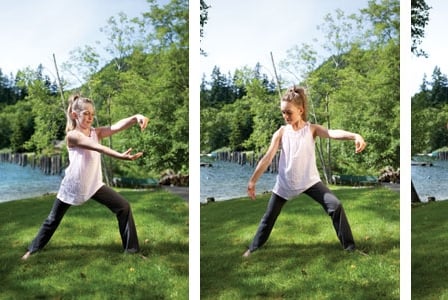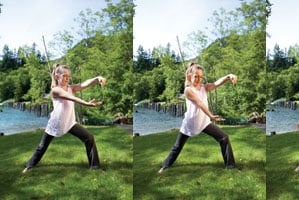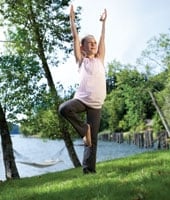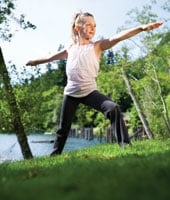
Children can benefit from mind-body exercise. Performing yoga or tai chi increases confidence and the ability to focus on academic tasks.
“Do not let the demands of an overly active world rob your children of their peace. Constant stimulation without balance of quietness creates chaos.” —The Parent’s Tao Te Ching
Visit any of the many children’s yoga studios sprouting up in trendy city centres, and you will hear the instructor say things like, “Let’s practise our tree pose. Feel your roots growing deep into the earth. Feel steady and strong like a tree as you balance on one leg.”
Later, they might excite the children by asking them to become an angry cat, a barking dog, a lithe cobra, or a brave warrior. In tai chi class, children may be asked to visualize their breath as a bubble between their hands that’s expanding and contracting with their hands’ movements.
Imagination: gateway to a child’s inner calm
The beauty of a mind-body exercise for children is that it taps into their vivid imagination. Not only have the children connected the image in their mind’s eye with the movement of their body, but they also have fun without feeling the pressure to win or be better than anyone else but themselves.
This realization, together with awareness of breath and body, opens up a world of calm and self-assuredness that children may crave after a busy day. Indeed, all mind-body exercises teach children self-control through slow, deliberate movements that calm the psyche and challenge the body.
Success in school from sun salutations
There’s nothing Zen about children anticipating the start of school as summer winds down. As September looms, children need to get back into a regular sleep routine, the discipline of schoolwork, and organized after-school activities.
As parents, we all want to see our children achieve academic success. Studying, however, does not come naturally to most kids. Instead, many need constant help with schoolwork, and constant reminding to sit still and stay on task.
Mind-body exercises can translate into better focus and cognitive performance on academic tasks. The reason, according to one children’s yoga instructor, is that these types of exercises teach children what it actually means to be still and focused.
The children are shown stillness, not just told to be still, and they feel what it means to have total control over their movements using their mind. Mind-body exercises can help children relax and sleep better, improve their mental focus and attention span, and have fun in a calming, noncompetitive way.
Yoga can be especially helpful for children with hyperactivity, attention deficit, or other issues with concentration and patience. Regular practices can make a big difference in children’s ability to perform tasks without getting distracted.
Parents and teachers notice improvements in schoolwork and classroom behaviour. However, the most important benefit is the self-mastery and confidence children gain and carry with them for the rest of their lives.
Research also supports the positive effect of yoga and other meditative exercises on academic performance. In 2009 Chinese researchers found that students who practised yoga performed better in overall academics, as well as each individual subject. Students who did no mind-body exercise saw no improvements. These results were in tune with earlier studies, which found that meditation, practised over long periods, produced definite changes in perception, attention, and cognition.
Other studies show that yoga techniques help manage anxiety and improve concentration. Researchers have also found that practising yoga exercises improves academic performance and enhances problem-solving ability in children.
Physical and metabolic health benefits
Practising mind-body activities also helps children develop a greater awareness of their body and what it can do. Every child will start out differently, but with regular practice they can all increase their strength, improve balance and coordination, and enhance their overall fitness level. Children are naturally quite flexible but need to practise good body alignment (posture) and coordinated movements to realize the potential of their flexibility.
After an exciting “aha” moment of mastering a difficult pose, children of all ages quickly become hooked on mind-body exercises and start increasing in strength, stamina, agility, balance, coordination, and cardiovascular fitness.
Though meditative, these exercises are by no means passive. Some types of yoga or tai chi-based martial arts, such as kung fu, can burn as many calories as soccer practice. However, unlike traditional children’s after-school sports, mind-body exercises are low-impact and emphasize good body alignment to prevent injury.
For instance, in a single balancing posture in yoga such as “toppling tree,” children learn to move with grace and control, improving their core stability while strengthening large muscle groups and speeding up their metabolism.
Recent studies suggest that mind-body exercises such as yoga can lower blood pressure, heart rate, and respiratory rate in children and young adults. The yoga corpse pose, or savasana, reduced blood pressure in young women when practised regularly for 12 weeks straight.
More physical mind-body exercises, such as kung fu, may yield greater health outcomes including increased lean muscle mass and improved blood sugar control, particularly in children with body weight issues.
After-school “om”-time
Health Canada’s 2011 Active Healthy Kids Report Card on Physical Activity for Children and Youth reveals that only 8 percent of children are moderately to vigorously active during after-school hours.
According to parents, the vast majority, 73 percent, are watching TV, reading, or playing computer games instead of playing outside, doing an organized sport, chores, or even homework. The major barrier is lack of access to supervised after-school programs that have physical activity as their primary component.
If you can’t get to a children’s yoga class, there are instructional, age-appropriate CDs and DVDs for home use. Older children can use these resources on their own while younger children will enjoy “play time” with mommy and daddy pretending to be animals.
Take a few minutes after your busy day to try some of these poses with your child.
|
|
|
|

Snake Creeps Down (tai chi)
- In this tai chi posture the goal is to maintain fluidity while shifting most of your weight into the creeping-down leg.
- The back hand forms a bird’s beak (four fingers to the thumb), and the joints remain fluid, never locked; the lengthened leg remains slightly bent.
- Explain to kids that a snake must always be ready to rise or slither away at any given moment.


 Tree Pose (yoga)
Tree Pose (yoga) Peace Warrior (yoga)
Peace Warrior (yoga)